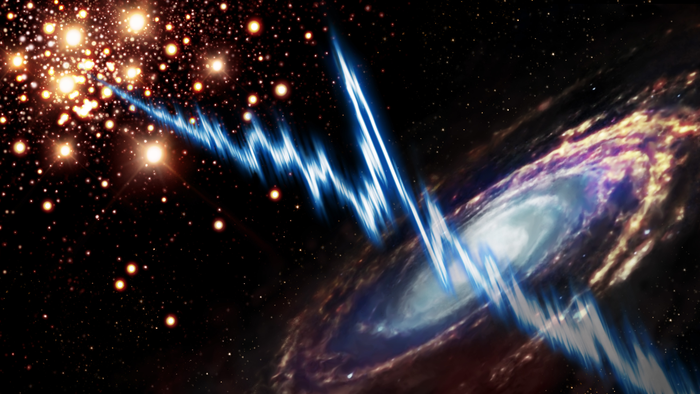
توضح هذه المحاكاة كيف تتشكل القضبان النجمية (على اليسار) وتدفقات الغاز إلى الداخل مدفوعة بالقضبان (على اليمين). تلعب القضبان النجمية دورًا مهمًا في تطور المجرة عن طريق توجيه الغاز إلى المناطق المركزية من المجرة ، حيث يتم تحويلها بسرعة إلى نجوم جديدة ، بمعدل أسرع من 10 إلى 100 مرة من المعدل في بقية المجرة. تساهم القضبان أيضًا بشكل غير مباشر في نمو الثقوب السوداء الهائلة في مركز المجرات عن طريق توجيه بعض الغاز. الائتمان: فرانسواز كومبس ، مرصد باريس
صور جديدة لـ[{” attribute=””>NASA’s James Webb Space Telescope (JWST) reveal for the first time galaxies with stellar bars — elongated features of stars stretching from the centers of galaxies into their outer disks — at a time when the universe was a mere 25% of its present age. The finding of so-called barred galaxies, similar to our Milky Way, this early in the universe will require astrophysicists to refine their theories of galaxy evolution.
Prior to JWST, images from the Hubble Space Telescope had never detected bars at such young epochs. In a Hubble image, one galaxy, EGS-23205, is little more than a disk-shaped smudge, but in the corresponding JWST image taken this past summer, it’s a beautiful spiral galaxy with a clear stellar bar.
“I took one look at these data, and I said, ‘We are dropping everything else!’” said Shardha Jogee, professor of astronomy at The University of Texas at Austin. “The bars hardly visible in Hubble data just popped out in the JWST image, showing the tremendous power of JWST to see the underlying structure in galaxies,” she said, describing data from the Cosmic Evolution Early Release Science Survey (CEERS), led by UT Austin professor, Steven Finkelstein.

The power of JWST to map galaxies at high resolution and at longer infrared wavelengths than Hubble allows it look through dust and unveil the underlying structure and mass of distant galaxies. This can be seen in these two images of the galaxy EGS23205, seen as it was about 11 billion years ago. In the HST image (left, taken in the near-infrared filter), the galaxy is little more than a disk-shaped smudge obscured by dust and impacted by the glare of young stars, but in the corresponding JWST mid-infrared image (taken this past summer), it’s a beautiful spiral galaxy with a clear stellar bar. Credit: NASA/CEERS/University of Texas at Austin
The team identified another barred galaxy, EGS-24268, also from about 11 billion years ago, which makes two barred galaxies existing farther back in time than any previously discovered.
In an article accepted for publication in The Astrophysical Journal Letters, they highlight these two galaxies and show examples of four other barred galaxies from more than 8 billion years ago.
“For this study, we are looking at a new regime where no one had used this kind of data or done this kind of quantitative analysis before,” said Yuchen “Kay” Guo, a graduate student who led the analysis, “so everything is new. It’s like going into a forest that nobody has ever gone into.”
Bars play an important role in galaxy evolution by funneling gas into the central regions, boosting star formation.
“Bars solve the supply chain problem in galaxies,” Jogee said. “Just like we need to bring raw material from the harbor to inland factories that make new products, a bar powerfully transports gas into the central region where the gas is rapidly converted into new stars at a rate typically 10 to 100 times faster than in the rest of the galaxy.”
Bars also help to grow supermassive black holes in the centers of galaxies by channeling the gas part of the way.
https://www.youtube.com/watch؟v=iBhsUQL1YPE
توضح هذه المحاكاة كيف تتشكل القضبان النجمية (على اليسار) وتدفقات الغاز إلى الداخل مدفوعة بالقضبان (على اليمين). تلعب القضبان النجمية دورًا مهمًا في تطور المجرة عن طريق توجيه الغاز إلى المناطق المركزية من المجرة ، حيث يتم تحويلها بسرعة إلى نجوم جديدة ، بمعدل أسرع من 10 إلى 100 مرة من المعدل في بقية المجرة. تساهم القضبان أيضًا بشكل غير مباشر في نمو الثقوب السوداء الهائلة في مركز المجرات عن طريق توجيه بعض الغاز. الائتمان: فرانسواز كومبس ، مرصد باريس
إن اكتشاف القضبان خلال هذه العهود المبكرة يزعج السيناريوهات التطورية للمجرات بعدة طرق.
قال جوجي: “هذا الاكتشاف للأعمدة الأولى يعني أن نماذج تطور المجرات لديها الآن مسار جديد عبر القضبان لتسريع إنتاج نجوم جديدة في العصور المبكرة”.
ووجود هذه الأعمدة المبكرة يتحدى النماذج النظرية لأنه يجب عليهم ضبط فيزياء المجرات بشكل صحيح من أجل التنبؤ بوفرة الشريط الصحيح. سيختبر الفريق نماذج مختلفة في مقالاتهم التالية.

يُظهر مونتاج صور JWST ستة أمثلة من المجرات المحظورة ، اثنان منها يمثلان أعلى الأوقات بأثر رجعي التي تم تحديدها وتمييزها كميًا حتى الآن. تُظهر الملصقات الموجودة في أعلى يسار كل شكل الزمن الرجعي لكل مجرة ، والذي يتراوح من 8.4 إلى 11 مليار سنة (جير) ، عندما كان الكون 40٪ إلى 20٪ فقط من عمره الحالي. الائتمان: ناسا / CEERS / جامعة تكساس في أوستن
يمكن لـ JWST أن يكشف عن الهياكل في المجرات البعيدة بشكل أفضل من هابل لسببين: أولًا ، المرآة الأكبر تمنحه قدرة أكبر على جمع الضوء ، مما يسمح له برؤية أبعد وبدقة أعلى. ثانيًا ، يمكنه الرؤية من خلال الغبار بشكل أفضل لأنه يراقب أطوال موجات الأشعة تحت الحمراء الأطول من تلسكوب هابل.
لعب الطلاب الجامعيين Eden Wise و Zilei Chen دورًا رئيسيًا في البحث من خلال الفحص البصري لمئات المجرات ، والبحث عن تلك التي يبدو أنها تحتوي على قضبان ، وتضييق القائمة إلى بضع عشرات للآخرين. يمكن للباحثين تحليلها بمزيد من التركيز. نهج رياضي. يقترب.
المرجع: “أول نظرة على z> 1 Bars في بقية الإطار القريب من الأشعة تحت الحمراء مع تصوير JWST المبكر CEERS” بقلم يوشن جو ، شاردا جوجي ، ستيفن إل فينكلستين ، زيلي تشين ، إيدن وايز ، ميكايلا بي باجلي ، جيليرمو بارو ، ستيجن وويتس ، دايل د. كوسيفسكي ، جيهان س. كارتالتيبي ، إليزابيث ج. ماكغراث ، هنري سي فيرجسون ، بهرام موباشر ، ماورو جيافاليسكو ، راي إيه لوكاس ، جورج أ.زافالا ، جينيفر إم لوتز ، نورمان أ.جروجين ، مارك Huertas-Company، Jesús Vega-Ferrero، Nimish P. Hathi، Pablo Arrabal Haro، Mark Dickinson، Anton M. Koekemoer، Casey Papovich، Nor Pirzkal، LY Aaron Yung، Bren E. Backhaus، Eric F. Bell، Antonello Calabrò، Nikko جي كليري ، روزماري تي كوغان ، إم سي كوبر ، لوكا كوستانتين ، دارين كروتون ، كيلسي ديفيس ، ألكسندر دي لا فيغا ، أفيشاي ديكيل ، ماكسيميليان فرانكو ، جوناثان بي غاردنر ، بين دبليو هولويردا ، تايلور أ.هوتشيسون ، فيراج بانديا ، قبل بابلو جي بيريز-غونزاليس ، وسوارا رافيندراناث ، وكيتلين روز ، وجوناثان آر.ترامب ، وويتشن وانغ ، رسائل من مجلة الفيزياء الفلكية.
arXiv: 2210.08658
المؤلفون المشاركون الآخرون من جامعة أوستن هم ستيفن فينكلشتاين وميكايلا باجلي وماكسيميليان فرانكو. يأتي العشرات من المؤلفين المشاركين من مؤسسات أخرى من الولايات المتحدة والمملكة المتحدة واليابان وإسبانيا وفرنسا وإيطاليا وأستراليا وإسرائيل.
تم توفير التمويل لهذا البحث جزئيًا من قبل Roland K. Blumberg Endowment in Astronomy ، ومؤسسة Heising-Simons ، و NASA. استند هذا العمل إلى موارد مركز الحوسبة المتقدمة في تكساس ، بما في ذلك Frontera ، أقوى كمبيوتر عملاق في جامعة أمريكية.

“هواة الإنترنت المتواضعين بشكل يثير الغضب. مثيري الشغب فخور. عاشق الويب. رجل أعمال. محامي الموسيقى الحائز على جوائز.”




